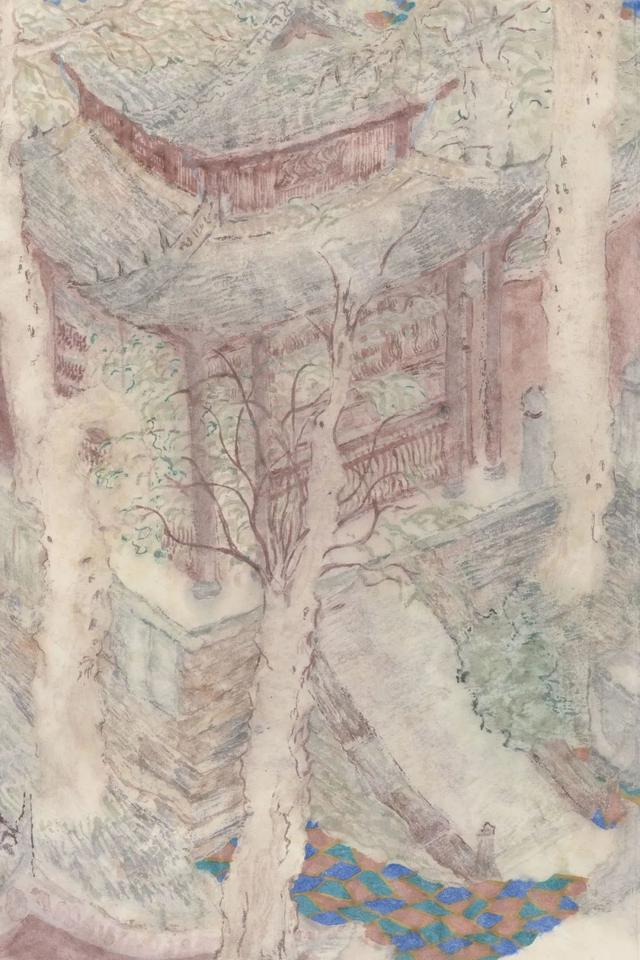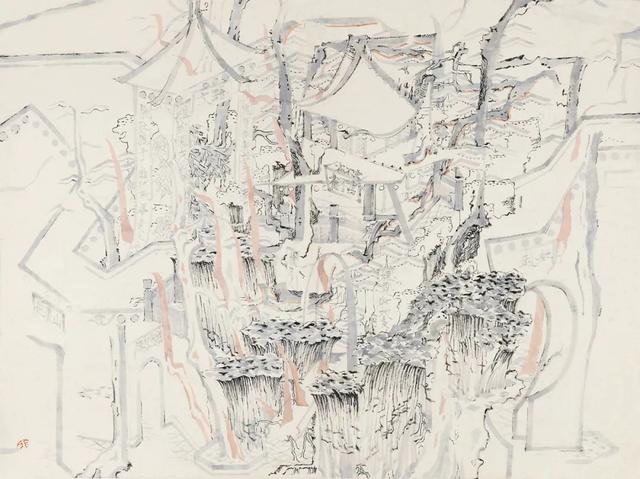
谁人得似张公子
Who Could Rival Master Zhang
张大箴个展
Zhang Dazhen Solo Exhibition
2025.5.3-7.6
策展人:付晓东
Curator: Fu Xiaodong
Opening:2025.5.3 15:00
地址 | Address:北京市朝阳区酒仙桥路四号798艺术区 中一街 空间站
Space Station, No.4 Jiuxianqiao Rd, 798 Art District, Beijing

下巴星河
The Star River on the Chin
纸本设色 Ink and color on paper
33×66cm 2025

“我该怎么办”“我也不知道我该怎么办”
"What Should I Do?" "I Don’t Know Either."
纸本设色 Ink and color on paper
33×66cm 2023
人化的自然——关于张大箴个展
空间站很荣幸的即将在2025年5月3日举办张大箴的首次个展。他出身于杭州的绘画世家,从小得天独厚,耳熏目染,中国美院山水专业本科毕业后,在北京读的何加林老师的硕士,又是卓鹤君老先生的博士生高徒,现在广州美院国画系任教。张大箴的创作形成了独特的个人语言风貌,既有传统扎实的笔墨功力,又不乏探索和创新的勇气,是90后水墨青年艺术家中个性鲜明,语言面貌成熟的代表。

眼下的绿与芭蕉无关
The Green Before Me, Not of the Banana Plant
纸本设色 Ink and color on paper
33×66cm 2025

眼下的绿与芭蕉无关(局部)
The Green Before Me, Not of the Banana Plant (Detail)
水墨作为一种传承千年,本身具有中国性身份的艺术媒介,一直是中国当代艺术中重要的组成部分。关于水墨的剧烈变革伴随着八十年代开启的八五运动,应运而生的谷文达、杨诘昌所代表的活跃于世界舞台的作为当代艺术的水墨创作,国内声势浩大的抽象水墨运动,以及一系列在此思潮背景下的新文人画,新学院派,新工笔等等层出不穷的当代的水墨创作样态。在传统传承与现当代观念的相互冲突下,水墨艺术在传承、发展、变革之间,衍生出了各种不同的路径。在众语喧哗之中,完全西化和照抄西方样式,已经成为一个略带否定性的样态。在挖掘本土特点与开拓当代性认知之间,如何寻找出理想路径是依然需要解决的问题。当透彻的研究了传统中笔墨经典的十八般武艺之后,水墨还能怎样?张大箴就是这样一个典型的个案。

烟花算法
The Fireworks Algorithm
纸本设色 Ink and color on paper
33×66cm 2025

带大伙参观老张的心脏
Let’s Take a Look Inside Old Zhang’s Heart
纸本设色 Ink and color on paper
33×66cm 2025

带大伙参观老张的心脏(局部)
Let’s Take a Look Inside Old Zhang’s Heart(Detail)
中国艺术史随着理论体系的研究,不断向着社会学、考古学的跨学科意识扩展,但是核心的文人画体系的高峰依然是笔墨语言的完善体系。艺术家们面对这些已有的思维体系和创作路径,个人意志的判断和选择,抉定着艺术实践的铺陈展开。张大箴属于迎难而上的典型。他的博士论文写的是《清初山水画技法研究》,把最盛产绘画文献的年代的画史、画论、画谱、画跋等深入研究,将论调高远的理论转化成为可以实践的方法,从各种蛛丝马迹处入手,研究他们是“怎么画出来的?”这是他在探索古人画作过程中破解千古谜题的指南攻略,程式化一览手册,文人画规范全集。也反映了他对象化古人的一种方式,将其作为一种可以破解,可以选择,可以抵达的武备技能库里其中的一种。可以在他的画作中看到中,他对古人的山石法、树法、云水法和章法,研究充分,即使用最苛刻的传统技法的评价体系中去判别,亦可以无懈可击。

公子的吹牛耳返
The Nobleman’s Bragging Echoes Back to Him
纸本设色 Ink and color on paper
33×66cm 2024

公子的吹牛耳返(局部)
The Nobleman’s Bragging Echoes Back to Him(Detail)
从一个艺术学徒到艺术家的转变是潜移默化的,对本人来说是一种自然而然,其实是一个巨大的潜意识的积累之后的发芽,和持之以恒的茁壮生长。在一个厚重的传统重镇之中,则更需要勇气,尤为不易。这棵逐渐变异的小苗,在读研阶段初见端倪,在读博阶段愈发完善。在写生中,纷繁芜杂的细节和目不可及的层层叠叠的空间,逐渐被打散、解构,重组,从新以一种画面自身的秩序排列在画纸之上。读硕期间,何加林的线面分割思维与错综变化的笔墨语言影响了大箴对于笔墨当代性的探索。读博期间,卓鹤君对山水空间的实验性以及山水哲思的抽象表达,激励了大箴对山水画的大胆求索。基于这一脉师承体系,大箴画面的抽象化处理,大面积使用点线分割与色彩融合,发展出了独具个人特点的画作面貌。

肺腑之言 属实心胃
Sincere Words, Truth to the Core
纸本设色 Ink and color on paper
33×198cm 2024

肺腑之言 属实心胃 (局部)
Sincere Words, Truth to the Core(Part)

肺腑之言 属实心胃 (局部)
Sincere Words, Truth to the Core(Part)

肺腑之言 属实心胃 (局部)
Sincere Words, Truth to the Core(Part)
对于空间的特殊经验,是大箴早期实验的起点。写生是他的创作方式,也是生存方式。通过朝向外部事物的观看,他重新赋予了空间秩序,并通过物之表象之间不同肌理的变化着重建构了空间之中物与物之间的关系。空间中的建筑,随着人身体的运动不断的错位和转移,建筑和树木的表象互相外在,互相并列,互相挤压,如同外部世界四面八方的涌来。人的全部感觉,不仅五官感觉,还有精神感觉,都是由于对象的存在而产生。大箴的画抓住了这种“人化的自然”,一种身体的认识,感觉化自然,而非客观的自然。画面中神经般的树枝缠绕,丝丝缕缕,堆叠亭台的超现实空间组合,带有空气感的斑斓的色彩关系,密集层叠的潮湿瓦片,斑斑点点的偶然苔痕,是对此时此地环境的独特体知和切肤之感。在表达现象和纯形式的时候,是潜藏在人的灵魂深处的一种技术。我们任何时候都很难从自然手中获得破解的机关,把它无所遮蔽的摆在眼前。大箴试图把那些偶然的可用,生命的痕迹,粗糙的存在,从隐蔽的狭隘处解放出来,变得可感而澄清,变成一种上手状态的空间。他亦用一些只有针对他自己有意义的词句为他的绘画命名《肺腑之言,实属心胃》、《我吃完的冰棒总会掉在画眼上》、《你的毛衣卡在墙角与墙角之间》,使原初空间不再是客观空间,而是由我的使用操作和上手状态决定,成为一种彰显着人的存在的实践空间,也使空间成为一种身体图示。

烟花过境复兴
Revival After the Fireworks Fade
纸本设色 Ink and color on paper
43×57cm 2021
经过十年的精心锤炼,思维密集型的大箴融合了对传统的基础以及对画面本体语言的出人意表的探究,已经形成了一套完整的个人绘画语言系统。他大量使用日本岩彩画的颜色,却如同传统规范的墨法一般层层渲染,驻留笔痕,使颜色厚重而流动,丰富而透明。再衬以有笔有墨的钩提点染,神经质的线条穿梭其中。各种色阶的橙紫对比,红绿对比,代替了墨色呼应,响亮而不失雅致。画面布局巧妙的运用相间法和互称法,使方寸之间变化错综,光影流动,琳琅满目。画面中充满了理性的对比关系,和谐韵律的氛围节奏,其中的最动人处既是他以笔墨为媒介对自然的人化,把感觉化为点掇而成的几笔点叶,几块瓦片,或者几棵树之间具体而微的偶然性的特殊关系。他用粉红、蓝紫、橙黄等颜色大面积填染背景,使画面中充满细节的苔痕、树干、草地、亭台如同宝石一般镶嵌在画间,璀璨夺目,宛如此刻当下的感知。
付晓东 2025.4.21于杭

小泌的本星乐园
Xiaomi’s Native Star Paradise
纸本设色、框架装置
Ink and color on paper、framed installation
250×250cm 2020
Humanized Nature:On Zhang Dazhen's Solo Exhibition
Space Station Gallery is honored to present the debut solo exhibition of Zhang Dazhen, opening on May 3rd, 2025. Born into a distinguished painting family in Hangzhou, Zhang was immersed in a rich artistic environment from an early age. After earning his undergraduate degree in landscape painting from the China Academy of Art, he pursued his master’s degree under Professor He Jialin in Beijing and later became a doctoral student of the esteemed art historian Zhuo Hejun. He is currently teaching in the Chinese Painting Department at the Guangzhou Academy of Fine Arts.
Zhang Dazhen has developed a distinct artistic language that reflects a solid grounding in traditional brush-and-ink techniques as well as a courageous spirit of exploration and innovation. Among post-1990s ink artists, he stands out for his mature and individual style.

植物园在花果山的几楼
The Botanical Garden in the Heights of Flower-Fruit Mountain
纸本设色 Ink and color on paper
43×57cm 2019

发际线回购笔记
The Hairline Redemption Journal
纸本设色 Ink and color on paper
43×57cm 2020
As an art medium with a millennia-long history and intrinsic cultural identity, ink painting has remained a vital component of contemporary Chinese art. Since the 1980s and the rise of the '85 New Wave Movement, the field has witnessed radical transformations. Artists such as Gu Wenda and Yang Jiechang brought ink into the global contemporary art discourse, while the domestic scene saw the emergence of the Abstract Ink Movement. Various approaches such as New Literati Painting, New Academism, and Neo-Gongbi (meticulous style) flourished within this tide of reform. Amid the tensions between tradition and contemporary thought, ink art has diversified along multiple paths. In this noisy discourse, full Westernization and blind imitation of Western styles have increasingly been viewed with skepticism. The challenge remains: how to strike a meaningful balance between local characteristics and contemporary awareness? Zhang Dazhen represents a compelling case in this ongoing inquiry.

柏林柏林 Berlin in Two Acts
纸本设色 Ink and color on paper
33×66cm 2025
With the expansion of Chinese art historical research into interdisciplinary realms such as sociology and archaeology, theical literati painting system—anchored in brush-and-ink aesthetics—still holds its intellectual peak. Confronted with these established paradigms, artists must make personal judgments and choices that shape their practice. Zhang Dazhen is a model of this courage. His doctoral dissertation, A Study of Landscape Painting Techniques in the Early Qing Dynasty, meticulously analyzes the most prolific period of Chinese painting theory, drawing from painting histories, treatises, manuals, and colophons. He transforms lofty theories into practical methodologies, deciphering ancient techniques through minute details—an encyclopedic guide to literati painting methods. This reflects a conscious approach to objectifying the ancients, treating their works as decipherable systems within an accessible skillset. Even when evaluated through the strictest standards of traditional technique—such as methods of rendering rocks, trees, clouds, and compositional schemes—Zhang’s work is virtually flawless.

雷神洞下随机盛开的短暂夜
The Thunder God’s Cave and the Fleeting Bloom of the Night
纸本设色 Ink and color on paper
43×57cm 2025
The transformation from student to artist is often imperceptible, but in truth it results from the accumulation of subconscious growth and persistent cultivation. For someone rooted in such a weighty tradition, this transformation requires particular courage. Zhang’s unique artistic voice began to emerge during his graduate studies and further matured during his doctoral research. In his plein air work, he deconstructs the chaotic visual details and overlapping spatial layers of the natural world, rearranging them into new compositional orders governed by the logic of the painting itself. If Zhuo Hejun’s return from the United States in the 1980s marked a new hard-edged planar style, and if He Jialin further developed brush-and-ink into a language of surface and structure, Zhang has carried forward this lineage with increasing abstraction and bolder use of color, evolving a highly individualized visual vocabulary.

郁金香泡沫
The Bubble of Tulip Dreams
纸本设色 Ink and color on paper
33×66cm 2025
Zhang’s early experiments were rooted in his unique spatial perception. Sketching from life is not only his creative method, but a way of life. Through focused observation of the external world, he reconfigures spatial relationships based on the textures and surfaces of objects. Buildings in his paintings shift and displace with the viewer’s movement, overlapping with trees and other structures, compressing and juxtaposing in a way that mirrors the overwhelming influx of the external world. Human perception—sensory and spiritual alike—is evoked through its interaction with the object. Zhang captures this “humanized nature”: nature perceived through the body, rather than as an objective entity. His works depict neurotic, entangled tree branches; surreal accumulations of pavilions; vivid, airy color schemes; layers of damp roof tiles; and scattered moss-like textures—all conveying a visceral, embodied understanding of place. In these works, technique is not merely a means of depiction but something hidden deep within the soul. Nature rarely reveals its mechanisms, but Zhang attempts to liberate its accidental details and traces of life from obscurity, rendering them tangible and accessible—spaces that are not objective, but tactile and operative, marked by human presence.

一日之计在于凌晨
A Day’s Plan Begins at Midnight
纸本设色 Ink and color on paper
33×66cm 2025

一日之计在于凌晨(局部)
A Day’s Plan Begins at Midnight(Detail)
He also uses poetic and idiosyncratic titles such as Words from the Heart, Truly My Liver and Stomach, The Ice Pop I Ate Always Falls on the Pupil of the Painting, and Your Sweater Got Stuck Between Wall and Wall, which transform original space into subjective space—one defined by usage and touch. In doing so, he turns space into a diagram of bodily experience.
After a decade of intensive refinement, Zhang’s intellectually-driven approach—grounded in tradition yet startling in its visual innovations—has culminated in a complete personal painting system. He makes extensive use of color inspired by Japanese nihonga painting, applying it through successive layers akin to traditional ink washes, preserving brush marks and creating a surface that is simultaneously rich and luminous. Complemented by calligraphic strokes and neurotic lines, the color becomes a medium of emotion. Contrasting tones of orange and purple, red and green, replace the traditional interplay of ink values with vibrant but elegant harmony. His compositions use techniques of interspersion and mutual counterpoint to produce complex, dynamic arrangements filled with rhythmic movement and visual density. The most compelling aspects of his work lie in how he humanizes nature through brush and ink—transforming sensations into the nuanced relationships between a few scattered leaves, a patch of moss, or the interplay of tree trunks—turning fleeting impressions into visual gems. Against pastel backgrounds in pinks, blues, and oranges, these meticulously detailed elements shimmer like embedded jewels, evoking the present moment in all its sensory fullness.
Fu Xiaodong, April 21, 2025, Hangzhou

社会化园林的错觉
The Delusion of a Socialized Garden
纸本设色 Ink and color on paper
33×66cm 2025
关于艺术家
About Artist

张大箴
1990年生于浙江杭州。
2013年毕业于中国美术学院中国画系,获学士学位。
2016年毕业于中国艺术研究院,获硕士学位,导师何加林教授。
2020年毕业于中国美术学院中国画系,获博士学位,导师卓鹤君教授、万木春教授。
现任教于广州美术学院中国画学院,
为中国美术家协会会员。
Zhang Dazhen
Born in 1990 in Hangzhou, Zhejiang Province.
Graduated from the Department of Chinese Painting at China Academy of Art in 2013 with a Bachelor's degree.
Earned a Master's degree from the China National Academy of Arts in 2016, under the mentorship of Professor He Jialin.
Received a Doctorate from the Department of Chinese Painting at China Academy of Art in 2020, studying under Professors Zhuo Hejun and Wan Muchun.
Currently teaching at the School of Chinese Painting, Guangzhou Academy of Fine Arts.
Member of the China Artists Association.
